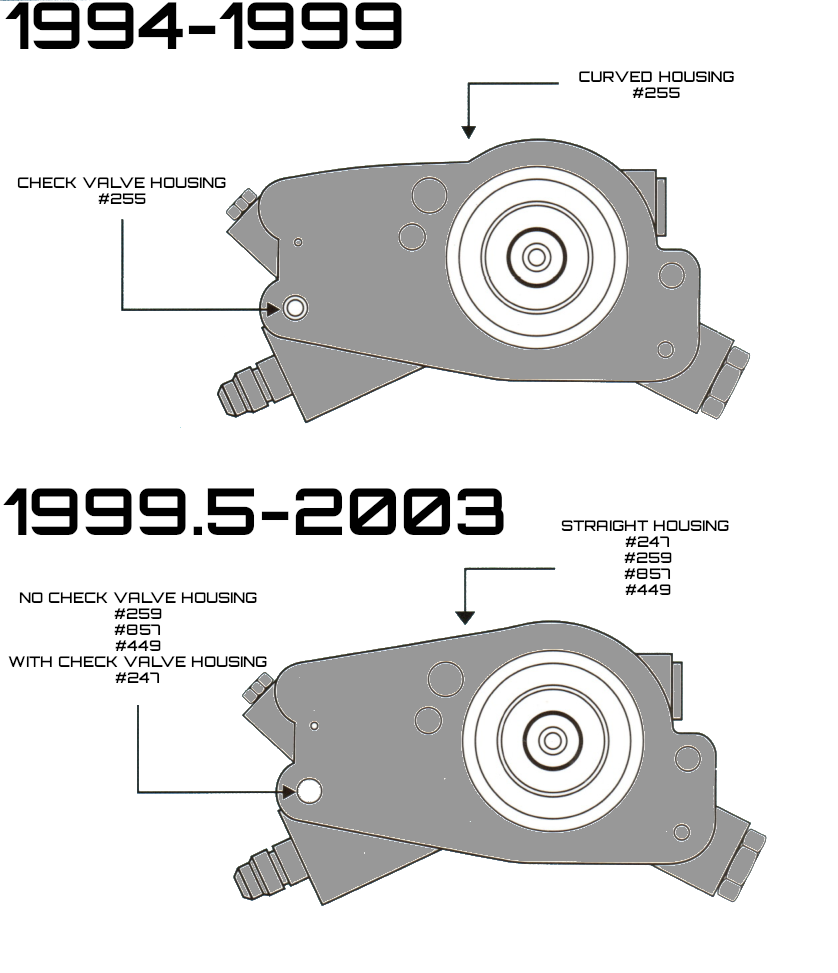In the Know for Ford 7.3L Power Stroke High-Pressure Oil Pump
Posted by Big Dawg Diesel on Apr 8th 2025
The Complete Guide to High-Pressure Oil Pumps (HPOP) for 1994-2003 Ford 7.3L Power Stroke Diesel
I'm just going to throw this blog out here for anyone who is interested in the 1994-2003 Ford 7.3L Power Stroke truck and needs a bit of know-how of the high-pressure oil pump that goes with this truck. The 7.3L Power Stroke (1994-2003) is one of Ford’s most legendary diesel engines, its well known for its durability and torque. The High-Pressure Oil Pump (HPOP) is both its lifeblood and one of its most misunderstood components, in the 1994-2003 Ford 7.3L Power Stroke engine, as it plays a vital role in the HEUI (Hydraulically Actuated Electronically Controlled Unit Injector) fuel injection system by delivering the necessary oil pressure to operate the fuel injectors. Understanding the history, design, function, common failure points, troubleshooting, and diagnostic codes associated with the HPOP will help truck owners keep their 7.3L Power Stroke running at peak performance. In other word, you need to make sure your HPOP is working properly in order for your diesel injectors to work in conjuntion with each other.
History of the High-Pressure Oil Pump in the 7.3L Power Stroke
The 7.3L Power Stroke diesel engine, introduced by Navistar International and Ford in 1994, being Ford’s first true modern diesel, replacing the IDI (Indirect Injection) 7.3L, was engineered to provide reliable power, especially for heavy-duty applications. This engine used the HEUI injection system, which required oil pressure to actuate the fuel injectors instead of a traditional cam-driven mechanical system.
The HPOP was developed to supply oil pressure to the injectors, allowing precise fuel metering and improved performance. Over the years, Ford refined the HPOP to enhance reliability, but like any mechanical component, it is prone to wear and failure over time.
Physical Differences in HPOP Design
The 1994-2003 Ford 7.3L Power Stroke engines used two main versions of the HPOP:
- 1994-1999 (Early Model) HPOP:
- Used a single-stage pump with lower pressure output.
- Features a 10-bolt reservoir cover.
- Equipped with smaller internal plungers, leading to slightly reduced volume.
- 1999.5-2003 (Late Model) HPOP:
- Upgraded to a higher-volume pump for better injection pressure.
- Features a 17-degree swashplate (compared to the earlier 15-degree), allowing for improved oil flow.
- Modified reservoir design for improved oil retention.
- Some models come with an electronic pressure sensor (ICP) to monitor oil pressure.
All this mumbo is nice and all but here is a picture so you can see the physical difference

Owners of early model 7.3L Power Strokes often upgrade to the later HPOP for increased reliability and performance.
Basic Functions of the High-Pressure Oil Pump
The HPOP provides pressurized engine oil to the HEUI injectors, enabling the precise fuel delivery needed for optimal performance. Here’s how it works:
- Oil Supply: The pump receives low-pressure oil from the engine’s lubrication system.
- Pressurization: The internal pistons and swashplate mechanism increase oil pressure, usually between 500–3,000 PSI, depending on engine demand.
- Injection Activation: This pressurized oil is sent to the injectors, where it forces fuel into the combustion chamber at high pressures.
- Pressure Regulation: The Injection Control Pressure (ICP) sensor and Injection Pressure Regulator (IPR) valve adjust the HPOP’s output based on driving conditions.
Without a properly functioning HPOP, the injectors won’t receive enough pressure to deliver fuel effectively, leading to performance issues and drivability concerns.
Common Reasons Why the HPOP Fails
Despite being a robust component, the 7.3L HPOP can fail due to various reasons, including:
✅ O-Ring and Seal Deterioration – Over time, the seals and O-rings inside the HPOP can wear out, causing oil leaks and pressure loss.
✅ Worn Internal Components – The swashplate, plungers, and gears inside the pump can wear out, reducing the pump’s efficiency.
✅ Dirty or Contaminated Oil – Poor maintenance and dirty oil can cause debris buildup, restricting flow and damaging the pump’s internals.
✅ Injection Pressure Regulator (IPR) Valve Failure – The IPR valve, which controls oil pressure, can get stuck or clogged, leading to incorrect pressure levels.
✅ High Mileage and Extended Use – HPOPs typically last over 150,000 miles, but excessive towing or high-performance modifications can accelerate wear.
Common Trouble Codes Associated with a Failing HPOP
A malfunctioning HPOP will often trigger Diagnostic Trouble Codes (DTCs). Here are some key codes related to oil pressure issues:
- P1211 – ICP Higher/Lower Than Expected
- Indicates an oil pressure deviation due to a failing HPOP or IPR valve issues.
- P1212 – ICP Not at Expected Levels
- Suggests inadequate oil pressure reaching the injectors, often caused by a worn HPOP.
- P1280 – ICP Circuit Low
- Points to electrical issues with the ICP sensor or insufficient HPOP pressure.
- P1298 – IDM Failure
- Although related to the Injector Driver Module (IDM), it can indicate HPOP-related fueling problems.
- P1316 – IDM Codes Detected
- Can occur when inconsistent injection pressure affects injector performance.
Troubleshooting a Failing HPOP
If you suspect an HPOP issue, follow these diagnostic steps:
- Check for Oil Leaks: Inspect around the pump and high-pressure lines for leaks.
- Monitor ICP Pressure: Use a scan tool to check real-time injection control pressure.
- Test the IPR Valve: Remove and inspect the valve for clogs or mechanical failure.
- Listen for Hard Starts or Stalling: A weak HPOP will struggle to supply adequate pressure, leading to hard starts.
- Inspect Engine Oil Condition: Dirty or low oil levels can restrict the HPOP’s operation.
- Perform a High-Pressure Oil System Air Test: This test detects leaks in the oil system that might cause pressure loss.
Final Thoughts
The High-Pressure Oil Pump (HPOP) in the 1994-2003 Ford 7.3L Power Stroke is a vital component that ensures proper fuel delivery and engine performance. Understanding its history, function, common failure points, and troubleshooting methods will help you keep your Power Stroke diesel running efficiently for years to come.
For truck owners looking to maintain peak performance, regular oil changes, using high-quality lubricants, and keeping an eye on trouble codes will go a long way in preventing HPOP failures and extending the engine’s lifespan.

